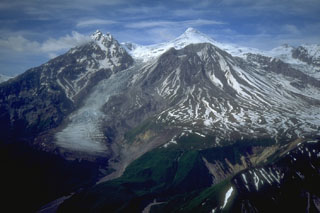Report on Spurr (United States) — 23 October-29 October 2024
Smithsonian Institution / US Geological Survey
Weekly Volcanic Activity Report, 23 October-29 October 2024
Managing Editor: Sally Sennert.
Please cite this report as:
Global Volcanism Program, 2024. Report on Spurr (United States) (Sennert, S, ed.). Weekly Volcanic Activity Report, 23 October-29 October 2024. Smithsonian Institution and US Geological Survey.
Spurr
United States
61.299°N, 152.251°W; summit elev. 3374 m
All times are local (unless otherwise noted)
The Alaska Volcano Observatory (AVO) reported that low-level unrest at Spurr was ongoing during 23-29 October. Several daily small earthquakes were recorded by the seismic network. No unusual activity was observed in mostly clear satellite or web camera data. Scientists visited Spurr on 24 October to perform pre-winter work including hardening the network and ensuring all systems were operational. During an overflight they observed vigorous steaming from the fumaroles in the summit crater and snow covering the vent at Crater Peak, a vent 3.5 km S of the summit. The Volcano Alert Level remained at Advisory (the second lowest level on a four-level scale) and the Aviation Color Code remained at Yellow (the second lowest level on a four-color scale).
Geological Summary. Mount Spurr is the closest volcano to Anchorage, Alaska (130 km W) and just NE of Chakachamna Lake. The summit is a large lava dome at the center of a roughly 5-km-wide amphitheater open to the south formed by a late-Pleistocene or early Holocene debris avalanche and associated pyroclastic flows that destroyed an older edifice. The debris avalanche traveled more than 25 km SE, and the resulting deposit contains blocks as large as 100 m in diameter. Several ice-carved post-collapse cones or lava domes are present. The youngest vent, Crater Peak, formed at the southern end of the amphitheater and has been the source of about 40 identified Holocene tephra layers. Eruptions from Crater Peak in 1953 and 1992 deposited ash in Anchorage.
Source: US Geological Survey Alaska Volcano Observatory (AVO)

